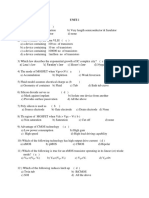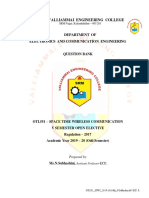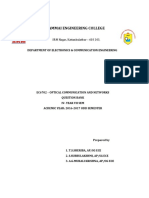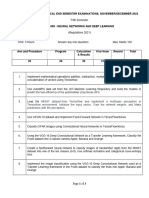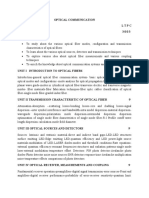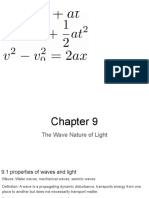Ec8751 Optical Communication LTPC3003 Objectives
Ec8751 Optical Communication LTPC3003 Objectives
Uploaded by
JAGAN SUBRAMANICopyright:
Available Formats
Ec8751 Optical Communication LTPC3003 Objectives
Ec8751 Optical Communication LTPC3003 Objectives
Uploaded by
JAGAN SUBRAMANIOriginal Title
Copyright
Available Formats
Share this document
Did you find this document useful?
Is this content inappropriate?
Copyright:
Available Formats
Ec8751 Optical Communication LTPC3003 Objectives
Ec8751 Optical Communication LTPC3003 Objectives
Uploaded by
JAGAN SUBRAMANICopyright:
Available Formats
EC8751 OPTICAL COMMUNICATION LTPC3003
OBJECTIVES:
To study about the various optical fiber modes, configuration and transmission characteristics of
optical fibers
To learn about the various optical sources, detectors and transmission techniques
To explore various idea about optical fiber measurements and various coupling techniques
To enrich the knowledge about optical communication systems and networks
UNIT I INTRODUCTION TO OPTICAL FIBERS 9
Introduction-general optical fiber communication system- basic optical laws and definitionsoptical
modes and configurations -mode analysis for optical propagation through fibersmodes in planar wave
guide-modes in cylindrical optical fiber-transverse electric and transverse magnetic modes- fiber
materials-fiber fabrication techniques-fiber optic cablesclassification of optical fiber-single mode fiber-
graded index fiber.
UNIT II TRANSMISSION CHARACTERISTIC OF OPTICAL FIBER 9
Attenuation-absorption --scattering losses-bending losses-core and cladding losses-signal dispersion –
inter symbol interference and bandwidth-intra model dispersion-material dispersion- waveguide
dispersion-polarization mode dispersion-intermodal dispersiondispersion optimization of single mode
fiber-characteristics of single mode fiber-R-I Profilecutoff wave length-dispersion calculation-mode field
diameter.
UNIT III OPTICAL SOURCES AND DETECTORS 9
Sources: Intrinsic and extrinsic material-direct and indirect band gaps-LED-LED structuressurface
emitting LED-Edge emitting LED-quantum efficiency and LED power-light source materials-modulation of
LED-LASER diodes-modes and threshold conditions-Rate equations-external quantum efficiency-
resonant frequencies-structures and radiation patterns-single mode laser-external modulation-
temperature effort. Detectors: PIN photo detector-Avalanche photo diodes-Photo detector noise-noise
sources-SNR-detector response time-Avalanche multiplication noise-temperature effectscomparisons of
photo detectors.
UNIT IV OPTICAL RECEIVER, MEASUREMENTS AND COUPLING 9
Fundamental receiver operation-preamplifiers-digital signal transmission-error sources-Front end
amplifiers-digital receiver performance-probability of error-receiver sensitivity-quantum limit. Optical
power measurement-attenuation measurement-dispersion measurement- Fiber Numerical Aperture
Measurements- Fiber cut- off Wave length Measurements- Fiber diameter measurements-Source to
Fiber Power Launching-Lensing Schemes for Coupling Management-Fiber to Fiber Joints-LED Coupling to
Single Mode Fibers-Fiber SplicingOptical Fiber connectors.
UNIT V OPTICAL COMMUNICATION SYSTEMS AND NETWORKS 9
System design consideration Point – to –Point link design –Link power budget –rise time budget, WDM –
Passive DWDM Components-Elements of optical networks-SONET/SDHOptical Interfaces-SONET/SDH
Rings and Networks-High speed light wave Links-OADM configuration-Optical ETHERNET-Soliton.
TOTAL:45 PERIODS
OUTCOMES: At the end of the course, the student should be able to: Realize basic elements in optical
fibers, different modes and configurations. Analyze the transmission characteristics associated with
dispersion and polarization techniques. Design optical sources and detectors with their use in optical
communication system. Construct fiber optic receiver systems, measurements and coupling
techniques. Design optical communication systems and its networks.
TEXT BOOKS: 1. P Chakrabarti, "Optical Fiber Communication‖, McGraw Hill Education (India)Private
Limited, 2016 (UNIT I, II, III) 2. Gred Keiser,"Optical Fiber Communication‖, McGraw Hill Education (India)
Private Limited. Fifth Edition, Reprint 2013. (UNIT I, IV, V)
REFERENCES: 1. John M.Senior, ―Optical fiber communication‖, Pearson Education, second
edition.2007. 2. Rajiv Ramaswami, ―Optical Networks ― , Second Edition, Elsevier , 2004. 3. J.Gower,
―Optical Communication System‖, Prentice Hall of India, 2001. 4. Govind P. Agrawal, ―Fiber-optic
communication systems‖, third edition, John Wiley & sons, 2004.
You might also like
- Advanced Lab: HeNe Laser Beam DivergenceDocument2 pagesAdvanced Lab: HeNe Laser Beam DivergenceAlejandro Ricardo Urzúa PinedaNo ratings yet
- TB Chapter1Document8 pagesTB Chapter1Benedick Jayson MartiNo ratings yet
- Ece Vii Optical Fiber Communication (06ec72) NotesDocument253 pagesEce Vii Optical Fiber Communication (06ec72) NotesVipin Ramachandran Pillai100% (1)
- Lesson Plan - Signals & Systems 2012Document3 pagesLesson Plan - Signals & Systems 2012KALAIMATHINo ratings yet
- Electronic Instrumentation July 2013Document0 pagesElectronic Instrumentation July 2013Prasad C MNo ratings yet
- EC3552 VLSI and Chip Design Lecture Notes 1Document297 pagesEC3552 VLSI and Chip Design Lecture Notes 1srinishraj05No ratings yet
- Ap7102 AdsdDocument5 pagesAp7102 AdsdshankarNo ratings yet
- EC8353 Electron Devices and Circuits - Course Page - College WebsiteDocument4 pagesEC8353 Electron Devices and Circuits - Course Page - College WebsiteAnusooya VNo ratings yet
- Ad Hoc and Wireless Sensor Networks - Ec8702: Session byDocument28 pagesAd Hoc and Wireless Sensor Networks - Ec8702: Session byRaja MadhuvanthiNo ratings yet
- IC FabricationDocument78 pagesIC FabricationSayandip Kar0% (1)
- Mixed Signal Ic Design Testing-1Document256 pagesMixed Signal Ic Design Testing-1vk. VenkatNo ratings yet
- RIC - 653 - Control Sys Lab-IDocument61 pagesRIC - 653 - Control Sys Lab-IVatsal MehrotraNo ratings yet
- 2017 Open Elective ECE SyllabusDocument58 pages2017 Open Elective ECE SyllabusSam Suresh80% (10)
- Question Bank - Part A: Unit I - Fundamentals of Computer GraphicsDocument48 pagesQuestion Bank - Part A: Unit I - Fundamentals of Computer GraphicsshaileshNo ratings yet
- VTU EC 6TH SEM SyllabusDocument35 pagesVTU EC 6TH SEM Syllabuskeerthans_1No ratings yet
- ADHOC UNIT-1 Applications PDFDocument32 pagesADHOC UNIT-1 Applications PDFNithish Kumar0% (1)
- Emb PT 08Document21 pagesEmb PT 08Anonymous IjquQOmNo ratings yet
- 03 - LN - Unit 1 - AdspDocument7 pages03 - LN - Unit 1 - AdspShiva Shankari MNo ratings yet
- Fingerprint Authentication: Name - Gaurav Singh Shekhawat ROLL NO. - 18EEBCS022Document14 pagesFingerprint Authentication: Name - Gaurav Singh Shekhawat ROLL NO. - 18EEBCS022gaurav singh shekhawatNo ratings yet
- Cmos Analog Ic Design Course Plan NewDocument9 pagesCmos Analog Ic Design Course Plan Newjim2001No ratings yet
- DSP Question Paper Unit 4Document2 pagesDSP Question Paper Unit 4shankarNo ratings yet
- Vlsi 2-Marks With AnswerDocument23 pagesVlsi 2-Marks With Answerk poornimaNo ratings yet
- Optical Communication Viva QuestionDocument2 pagesOptical Communication Viva Questiondivya1717No ratings yet
- Lpvlsi BitsDocument6 pagesLpvlsi BitsAravind AnapalliNo ratings yet
- Bci Unit 3Document28 pagesBci Unit 3personaluses3289No ratings yet
- EDC BitsDocument12 pagesEDC BitsKumar Goud.K0% (1)
- BSC Electronics Syllabus Kerala UniversityDocument64 pagesBSC Electronics Syllabus Kerala UniversityVarunRaj67% (3)
- ME Communication Systems R 2007 SyllabusDocument27 pagesME Communication Systems R 2007 SyllabusKathiravan SrinivasanNo ratings yet
- EC8702 AD HOC AND WIRELESS SENSOR NETWORKS SyllabusDocument2 pagesEC8702 AD HOC AND WIRELESS SENSOR NETWORKS SyllabusshanthiantonyNo ratings yet
- Cu9223 Microwave Integrated Circuits LT P CDocument1 pageCu9223 Microwave Integrated Circuits LT P CBala913No ratings yet
- Embedded Systems Syllabus PSGDocument15 pagesEmbedded Systems Syllabus PSGkumaranrajNo ratings yet
- EC8001 SyllabusDocument1 pageEC8001 SyllabusSarika AyyathuraiNo ratings yet
- 355 - EC8451 Electromagnetic Fields - 2 Marks With Answers 1 PDFDocument32 pages355 - EC8451 Electromagnetic Fields - 2 Marks With Answers 1 PDFBala913100% (1)
- TELE9753 Tutorial 5Document4 pagesTELE9753 Tutorial 5Charles WangNo ratings yet
- Digital Signal Processors and Architectures (DSPA) Unit-2Document92 pagesDigital Signal Processors and Architectures (DSPA) Unit-2Chaitanya DuggineniNo ratings yet
- Rmt DecodeDocument143 pagesRmt Decodedhadasabhishek70100% (1)
- Sem Q Paper - Analog CMOS D - T - 2021Document5 pagesSem Q Paper - Analog CMOS D - T - 2021SOHAN DEBNATH100% (1)
- First Semester: Es 15 101 System Design Using Embedded ProcessorsDocument2 pagesFirst Semester: Es 15 101 System Design Using Embedded ProcessorsFarah MafatNo ratings yet
- CMC Notes r20 Final 3Document143 pagesCMC Notes r20 Final 3gamerweebs786No ratings yet
- EC8561 COMMUNICATION SYSTEMS LabDocument1 pageEC8561 COMMUNICATION SYSTEMS Labvanithapremkumar50% (2)
- OTL551-Space Time Wireless Communication QUESTION BANK PDFDocument14 pagesOTL551-Space Time Wireless Communication QUESTION BANK PDFS.J Angelin PraveenaNo ratings yet
- Radar Engineering and Navigational Aids Question Bank UNIT 3Document1 pageRadar Engineering and Navigational Aids Question Bank UNIT 3Kommisetty MurthyrajuNo ratings yet
- EC6702-Optical Communication and Networks PDFDocument16 pagesEC6702-Optical Communication and Networks PDFAnonymous 1izmJeJNo ratings yet
- Physical Layer: Twisted-Pair CableDocument6 pagesPhysical Layer: Twisted-Pair CableNeenu PrasannanNo ratings yet
- Assignment 3Document19 pagesAssignment 3Sure AvinashNo ratings yet
- Ldica Course Info Sheet and Question BankDocument28 pagesLdica Course Info Sheet and Question BankDr.B.Krishna KumarNo ratings yet
- Analog & Digital VLSI Design Practice QuestionsDocument24 pagesAnalog & Digital VLSI Design Practice QuestionsAbhinav MishraNo ratings yet
- ECA 2markDocument4 pagesECA 2markthangarajelectresNo ratings yet
- EC8491 Notes PDFDocument90 pagesEC8491 Notes PDFgunasekaran kNo ratings yet
- VLSI BooksDocument5 pagesVLSI BooksKishore CkNo ratings yet
- Z Simple Non-Sequential System PDFDocument16 pagesZ Simple Non-Sequential System PDFbournwill100% (1)
- Design of Testable Sequential CircuitsDocument44 pagesDesign of Testable Sequential CircuitsMahesh S GourNo ratings yet
- CCS355 SET1 Anna University Lab Manual Question SetDocument3 pagesCCS355 SET1 Anna University Lab Manual Question SetPandi SelviNo ratings yet
- CMOS Process FlowDocument35 pagesCMOS Process Flowag21937570No ratings yet
- 2.1 Strip Lines3008221Document37 pages2.1 Strip Lines3008221Yash sutarNo ratings yet
- Unit-2-Optical Fibers Structures, Wave Guiding and FabricationDocument106 pagesUnit-2-Optical Fibers Structures, Wave Guiding and FabricationSHRIKESH SINGHNo ratings yet
- Analog and Digital Communication SyllabusDocument3 pagesAnalog and Digital Communication SyllabusSrinivas SamalNo ratings yet
- ELL 740 Compact Modeling of Semiconductor Devices: Dr. Abhisek DixitDocument45 pagesELL 740 Compact Modeling of Semiconductor Devices: Dr. Abhisek DixitChandan JhaNo ratings yet
- Optical Lecture 1 NUDocument96 pagesOptical Lecture 1 NUPhon PhannaNo ratings yet
- OCNDocument2 pagesOCNM Madhu MaliniNo ratings yet
- Optical Communication SyllabusDocument2 pagesOptical Communication Syllabuskrishna_ScrbidNo ratings yet
- 361 - EC8751 Optical Communication - Anna University 2017 Regulation SyllabusDocument2 pages361 - EC8751 Optical Communication - Anna University 2017 Regulation SyllabusPoonguzhaliNo ratings yet
- Light 8 QPDocument9 pagesLight 8 QPahmedNo ratings yet
- Worksheet - Microscope: Part A: How To Use A MicroscopeDocument2 pagesWorksheet - Microscope: Part A: How To Use A MicroscopeLeonita SwandjajaNo ratings yet
- Wave OpticsDocument3 pagesWave OpticsTarun GuptaNo ratings yet
- Experiment 11Document6 pagesExperiment 11Akshat GuptaNo ratings yet
- X-Ray DiffractionDocument26 pagesX-Ray DiffractionZain Ali KidwaiNo ratings yet
- PHA5/W: Physics (Specification A) PHA5/W Unit 5 Nuclear Instability: Astrophysics OptionDocument11 pagesPHA5/W: Physics (Specification A) PHA5/W Unit 5 Nuclear Instability: Astrophysics OptionAli WanNo ratings yet
- Light Reflection & Refraction Padhai Ak Mazza Best Handwritten Notes For 2023 Board ExaminationDocument16 pagesLight Reflection & Refraction Padhai Ak Mazza Best Handwritten Notes For 2023 Board Examinationabdul.aa.explorerNo ratings yet
- DLL Week 1 G 9 Science 22-23 Q2Document25 pagesDLL Week 1 G 9 Science 22-23 Q2Lady MayugaNo ratings yet
- CH203 Fall 2014 NMR Practice Quiz 1 Answers PDFDocument8 pagesCH203 Fall 2014 NMR Practice Quiz 1 Answers PDFBUCH20350% (2)
- Chapter 9Document13 pagesChapter 9Junyi JiNo ratings yet
- 1st Summative test.7-Nov.29-Dec. 6,2021Document2 pages1st Summative test.7-Nov.29-Dec. 6,2021karizajean desalisaNo ratings yet
- Science 10 Quarter 2 - Module 4: Uses of Mirrors and Lenses (REVIEWER)Document4 pagesScience 10 Quarter 2 - Module 4: Uses of Mirrors and Lenses (REVIEWER)Ella AuriaNo ratings yet
- Atomic StructureDocument21 pagesAtomic StructureShahriar ShafiNo ratings yet
- Light Ray Propagation in Optical FiberDocument8 pagesLight Ray Propagation in Optical Fiberdeepaknath2200No ratings yet
- Ray Optics Rudra SeriesDocument154 pagesRay Optics Rudra SeriesAniket kumarNo ratings yet
- Telescope - IntroductionDocument12 pagesTelescope - Introductionchandru bharathNo ratings yet
- Unit 3 Study Guide: Answer The Following Questions On A Separate Piece of PaperDocument2 pagesUnit 3 Study Guide: Answer The Following Questions On A Separate Piece of Paperapi-483662721No ratings yet
- EI2404Document2 pagesEI2404Jagadish Babu KondraguntaNo ratings yet
- Lesson 2 Types of Intermolecular Forces of AttractionsDocument63 pagesLesson 2 Types of Intermolecular Forces of AttractionsHillary Faith GregoryNo ratings yet
- Teaching Microscope Zeiss Primo StarDocument18 pagesTeaching Microscope Zeiss Primo StarAbd RaHmanNo ratings yet
- Atomic Structure PDFDocument4 pagesAtomic Structure PDFAlexia LudlowNo ratings yet
- X RaysDocument9 pagesX RaysKushagra C-251No ratings yet
- Structure of The Atom: 1. Ncert Intext QuestionsDocument10 pagesStructure of The Atom: 1. Ncert Intext QuestionsKumar AbhishantNo ratings yet
- Angular MeasurementDocument12 pagesAngular MeasurementArunNo ratings yet
- WWW - Thinkiit.in: Geometric OpticDocument13 pagesWWW - Thinkiit.in: Geometric OpticthinkiitNo ratings yet
- Stars Assessment ModelDocument2 pagesStars Assessment Modelapi-298519465No ratings yet
- Grade 10 Science Unit4Document187 pagesGrade 10 Science Unit4Horace BunagaNo ratings yet
- Experiment No-1 Photoluminance (PL: ObjectiveDocument10 pagesExperiment No-1 Photoluminance (PL: ObjectivejawaidaligNo ratings yet























